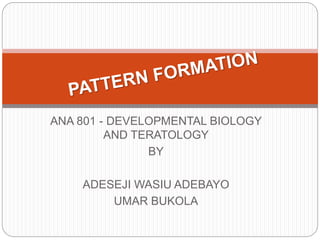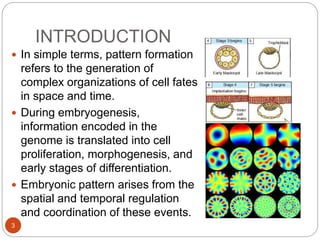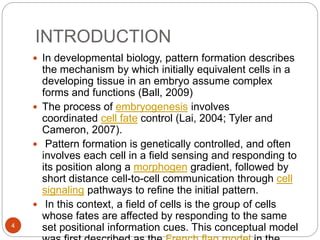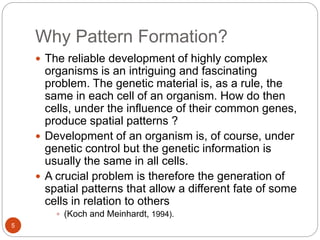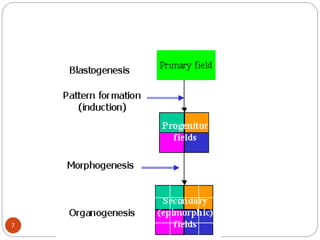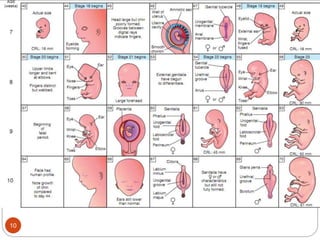PATTERN FORMATION
- 1. ANA 801 - DEVELOPMENTAL BIOLOGY AND TERATOLOGY BY ADESEJI WASIU ADEBAYO UMAR BUKOLA
- 2. OUTLINE 2 ï INTRODUCTION ï GENES OF PATTERN FORMATION ï CLINICAL IMPORTANCE ï CONCLUSION ï REFERENCES
- 3. INTRODUCTION 3 ï In simple terms, pattern formation refers to the generation of complex organizations of cell fates in space and time. ï During embryogenesis, information encoded in the genome is translated into cell proliferation, morphogenesis, and early stages of differentiation. ï Embryonic pattern arises from the spatial and temporal regulation and coordination of these events.
- 4. INTRODUCTION 4 ï In developmental biology, pattern formation describes the mechanism by which initially equivalent cells in a developing tissue in an embryo assume complex forms and functions (Ball, 2009) ï The process of embryogenesis involves coordinated cell fate control (Lai, 2004; Tyler and Cameron, 2007). ï Pattern formation is genetically controlled, and often involves each cell in a field sensing and responding to its position along a morphogen gradient, followed by short distance cell-to-cell communication through cell signaling pathways to refine the initial pattern. ï In this context, a field of cells is the group of cells whose fates are affected by responding to the same set positional information cues. This conceptual model
- 5. Why Pattern Formation? 5 ï The reliable development of highly complex organisms is an intriguing and fascinating problem. The genetic material is, as a rule, the same in each cell of an organism. How do then cells, under the influence of their common genes, produce spatial patterns ? ï Development of an organism is, of course, under genetic control but the genetic information is usually the same in all cells. ï A crucial problem is therefore the generation of spatial patterns that allow a different fate of some cells in relation to others ï (Koch and Meinhardt, 1994).
- 6. DEFINITION OF TERMS 6 ï Induction is the stimulation of a cell to differentiate in response to a stimulus produced by another cell. It is mediated by inducer substances that diffuse from one cell to another. It results in cell determination. ï Determination is the commitment of a cell to undergo differentiation. It is an irreversible process but is not accompanied by morphological changes. ï Determinants are the cytoplasmic effector molecules that mediate determination. ï Differentiation is the variation in the pattern of expression of a common set of genes to form cells of diverse morphology and function.
- 7. 7
- 8. 8
- 9. 9
- 10. 10
- 11. Time-table of landmarks in early human development 11 ï Day 1 - cleavage ï Days 2-4 - morula; free- floating conceptus in uterine tube ï Days 5-6 - formation of the blastocyst and embryoblast; ï - implantation ï Week 2 (days 7-14) ï - formation of the bilaminar embryo 0.1 mm ï Week 3 (days 15-20) - formation of the trilaminar embryo 1.0 mm ï Week 4 (days 21-28) ï Day 21 - formation of neural tube 2.0 mm ï Day 22 - formation of the heart ï Day 23 - formation of eye and ear rudiments ï Day 25 - formation of branchial arches ï Day 26 - formation of upper limb bud ï Day 28 - formation of the lower limb bud 5.0 mm ï Weeks 5 to 9 (2nd month) - Period of organogenesis ï Week 6 1.0 cm ï Week 9 4.0 cm
- 12. GENES OF PATTERN FORMATION 12 ï Every organism has a unique body pattern. ï This patterning is controlled and influenced by the HOMEOBOX genes. ï These specify how different areas of the body develop their individual structures, e.g. Arms, legs etc.
- 13. HOMEOBOX GENE 13 ï Homeotic genes are regulatory genes that determine where certain anatomical structures, such as appendages, will develop in an organism during morphogenesis. ï The expression of homeotic genes results in the production of a protein (homeodomain) that can turn on or switch off other genes. ï This genes act as Transcription factors.
- 14. HOX GENE 14 Human hox genes are collected into homeotic clusters. o There are 4 homeotic clusters, labelled A,B,C and D, oEach cluster is situated on a different chromosome. o Each homeotic cluster consists of 13 homeotic
- 15. The RNA expression pattern of three mouse Hox genes in the vertebral column of a sectioned 12.5-day-old mouse embryo: the anterior limit of each of the expression pattern is different Each Hox gene is expressed in a continuous block beginning at a Specific anterior limit and running posteriorly to the end of the developing vertebral column
- 16. HOX GENE 16 The four numerically corresponding genes for the four different clusters form a paralogous group. o The hox genes are responsible for patterning along the antero-posterior axis. o The genes are expressed sequentially beginning with the paralogous group 1, which is expressed first o The sequential genes specify different segments in cranio-caudal sequence extending from paralogous group 1, which specifies the most cranial structures, to paralogous group 13, which specifies the most caudal structures. o Thus the first genes to be expressed specify the most cranial structures while the last to be expressed specify the most caudal structures. This is responsible for the cranio-caudal sequence of development, where the more cranial segments develop slightly before the more caudal structures. Consequently the upper limb develops ahead of the lower limb.
- 17. Clinical Correlates 17 ï Mutations in genes of pattern formation leads to a lot of clinical important congenital malformations and anomalies ï Aniridia ï Synpolydactyly ï Axenfeld-Rieger syndrome ï Branchiootorenal syndrome ï Coloboma ï Langer mesomelic dysplasia ï LÃĐri-Weill dyschondrosteosis ï Microphthalmia ï Mowat-Wilson syndrome ï Amelia ï Limb deformities
- 18. Synpolydactyly 18 Mutation in the HOX D13 gene.
- 19. Aniridia 19 Aniridia with PAX6 gene mutation.
- 20. Axenfeld-rieger syndrome 20 mutations in one of the genes known as PAX6, PITX2 and FOXC1.
- 21. REFERENCES 21 âĒ A. J. Koch and H. Meinhardt (1994). Biological Pattern Formation : from Basic Mechanisms to Complex Structures. Rev. Modern Physics 66, 1481-1507 âĒ Ball, (2009). Shapes, pp. 261â290. âĒ Eric C. Lai (2004). "Notch signaling: control of cell communication and cell fate" 131 (5). pp. 965â73. doi:10.1242/dev.01074 âĒ Melinda J. Tyler, David A. Cameron (2007). "Cellular pattern formation during retinal regeneration: A role for homotypic control of cell fate acquisition". Vision Research 47 (4): 501â
- 22. FOR LISTENING 22
Editor's Notes
- #10:  time-table of  landmarks in early human development Day 1           - cleavage Days 2-4       - morula; free-floating conceptus in uterine tube Days 5-6       - formation of the blastocyst and embryoblast;                    - implantation Week 2 (days 7-14)                             - formation of the bilaminar embryo      0.1 mm Week 3 (days 15-20)                    -formation of the trilaminar embryo       1.0 mm Week 4 (days 21-28) Day 21         - formation of neural tube                     2.0 mm Day 22         - formation of the heart Day 23         - formation of eye and ear rudiments Day 25         - formation of branchial arches Day 26         - formation of upper limb bud Day 28         - formation of the lower limb bud          5.0 mm Weeks 5 to 9 (2nd month) - Period of organogenesis Week 6                                                         1.0 cm Week 9                                                         4.0 cm End of embryonic period

